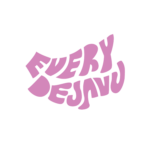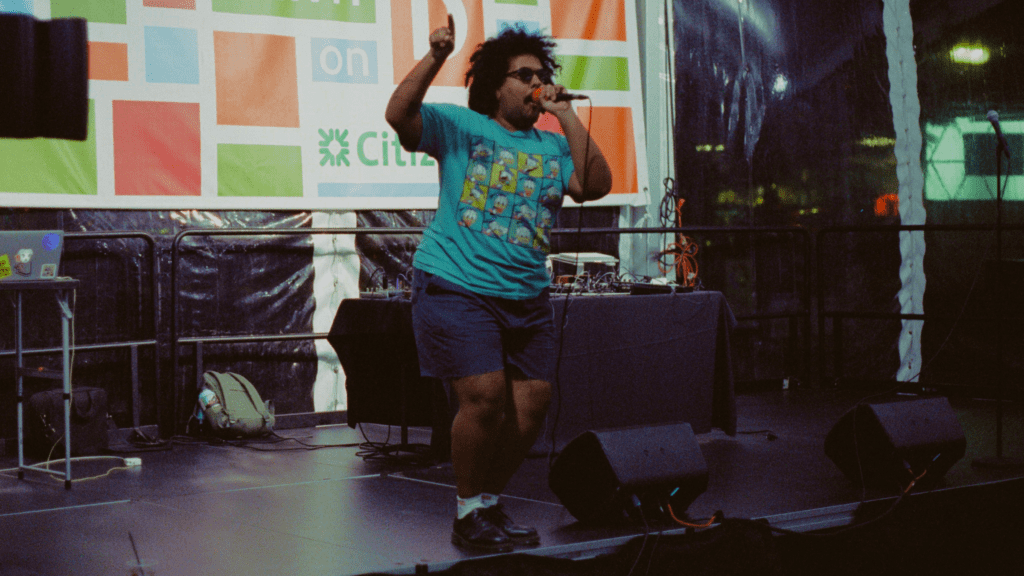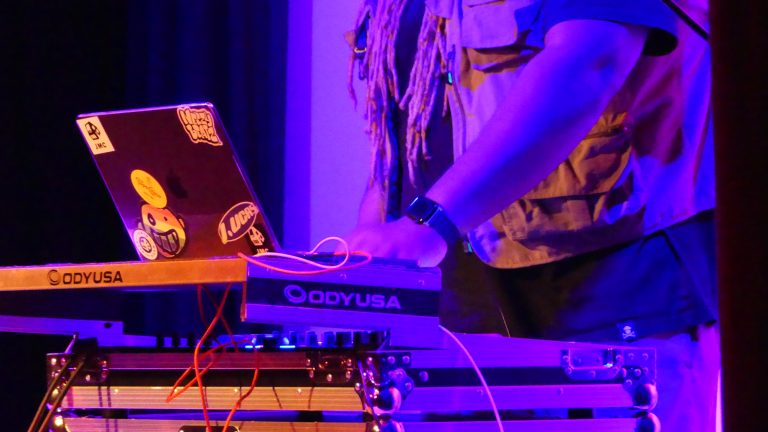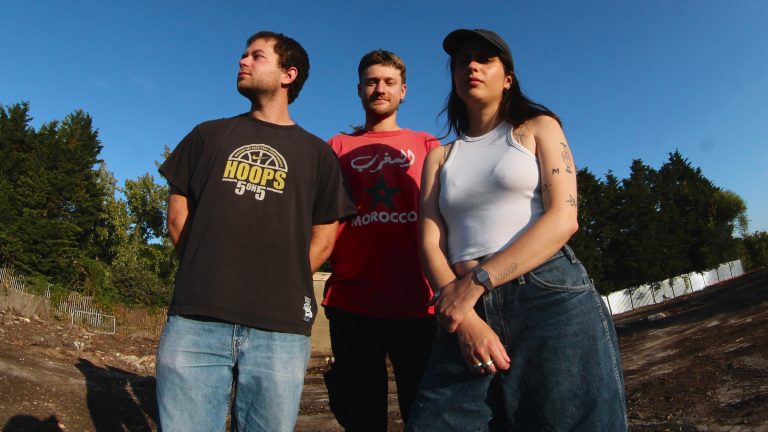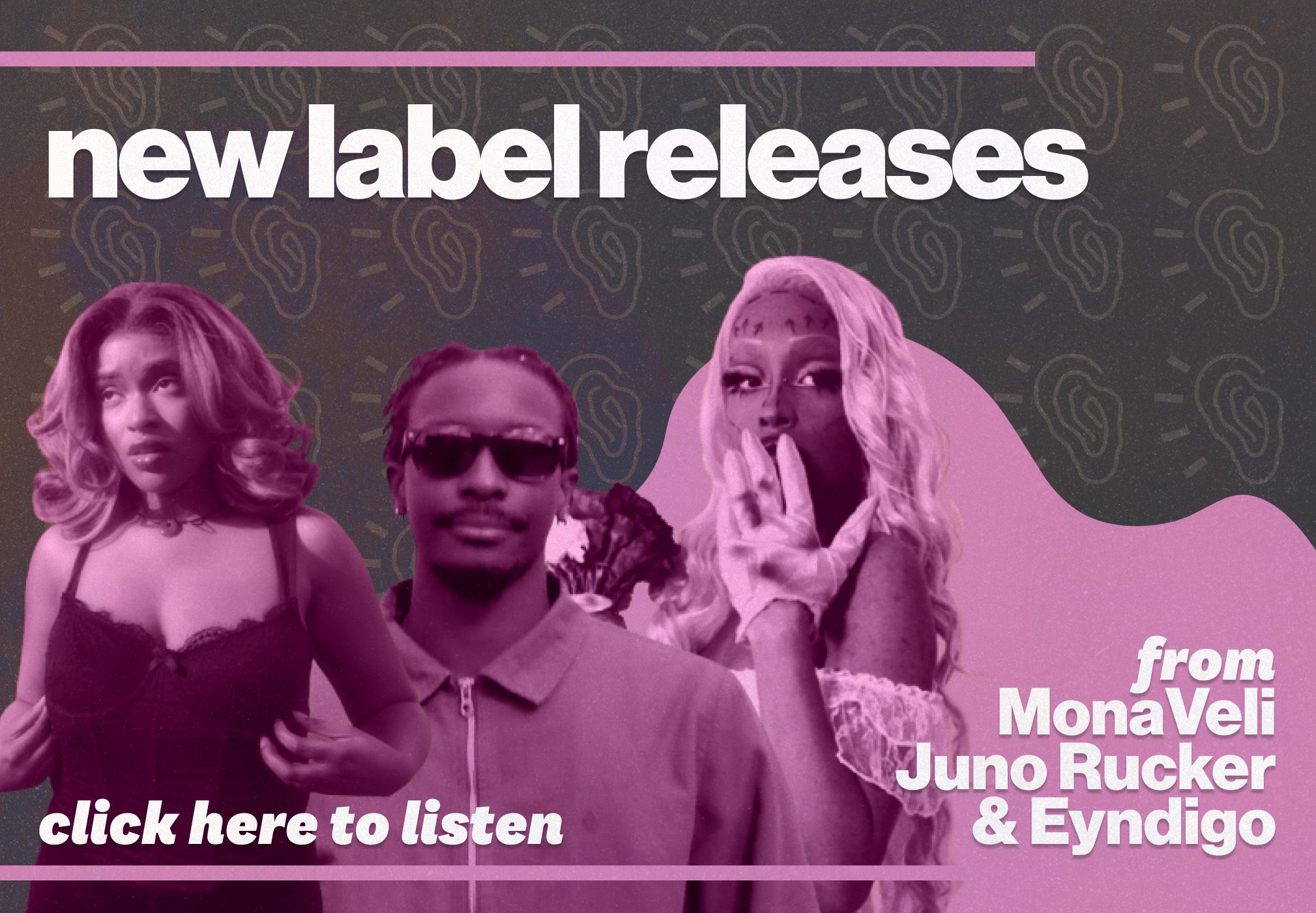When Pink Navel likes something, they love it, and it becomes a part of them. Their artist name derives from Steven Universe, they make songs dedicated to The Legend of Zelda characters, they write songs about dreaming of going to Magic Kingdom at Disney World, they review the flavor notes of beer during their live sets. How To Capture Playful, Devin Bailey’s latest album, is an ode to being a nerd and a demonstration of what that looks like for them. Released on record label and collective Ruby Yacht, How To Capture Playful was entirely produced by Kenny Segal, best known for his work with billy woods, but who has also produced for Ruby Yacht founder R.A.P. Ferreira, Open Mike Eagle, Busdriver, among others. Everyone has an inner nerd similar to Pink Navel, and for those who haven’t quite found their inner nerd or are on searching for it, they offer this album as a guide.
I listened to the joyful art rap album for almost two months before seeing the Massachusetts-born artist open for Open Mike Eagle at The Sinclair in Cambridge, MA. At the time, I had already done this interview and was sitting on it, waiting for the spark of motivation and inspiration to hit. But while standing next to fans who knew the words to the beloved hometown opener, one of the album’s messages hit me like a Super Mario Bob-omb. The purpose of this blog started from a place of excitement—writing about music I love without needing to overthink it. Hearing How To Capture Playful performed live was a reminder to have fun with it. As they performed, Pink Navel’s voice extended to their whole body; their arms and chest were directed to the energy of the music playing from their SP-404. They played clips of cartoons and old commercials sampled and distorted, leading us to further sink into their world of whimsy. As Pink Navel does with video games, this is a world I can escape to. Thanks to this, I finally put this all together in a way that got it out of me, instead of random, over-intellectualized one-liners in my head.
How To Capture Playful is their strongest work to date, as it feels like Bailey’s messaging is clearer than ever when it comes to telling their life story and experiences. We’ve heard them use video game and cartoon references before, but each stacks up as a vessel to tell their story throughout the album in carefully woven rap stitches that connect their life to these passions. But sometimes it is just that: references and ways of paying homage to their favorite games and cartoons, as a way to show love to the things in their life that they feel so dear about. This is all done over the beats of musical wizard Segal, who brings a large range of sounds for Pink Navel to dance over. The choice of production is eccentric, varying from chill, piano-laden tracks to video game soundtrack-esque, distorted, epic-themed beats that all lend perfectly to Pink Navel’s diverse style.
Before their tour with Open Mike Eagle, we talked over the phone with Pink Navel to discuss what it’s like to go on tour with someone they look up to, the beginning of their collaborations with Kenny Segal, the Boston music scene, and their monthly beat series called Knobs.
How was your album release show in Boston and New York with Fielded and Kayana?
It went really well. It was really serendipitous that Fielded and my record came out so close to each other—with the nature of the collaboration and all—we thought it would be fun. We had the challenge of getting the shows together last minute, but I’m really glad with how they both went. Especially in Boston, there was a great turnout. There were so many unknowns about that gig. I’d never been to the venue much, I didn’t know if people were going to come, I didn’t know if people knew about Warehouse XI [the venue]. But it was a solid turnout. I can’t complain, and it was so much fun to see Fielded and Kayana play in both cities. It was kind of a big ask, so it was cool to have that same bill, a kind of mini-tour/weekender thing. I played for, like, an hour—it was crazy. And I was exhausted, but I’m glad I pushed myself to do it.
I know you’ve been doing a lot of shows this year, and you’ve been doing them for a while. Have you felt a sense of improvement in performing?
To be totally transparent, I feel like [my] endurance is still something I’d like to improve. I’ve gotten a lot better at chewing the fat in my set. I like to be silly, and I like to do funny stuff. But sometimes, it might detract from the real reason people come to see me play: to hear the songs. I’ve been trying hard to bring the focus back to the music and sneak in some funny bits and some weird little samples but to refocus the idea that I’m supposed to be playing the songs. I think the songs being so good, like the best I’ve ever had, adds to that pressure to really showcase as many as I can—within any time limit.
You started out doing the whole DIY-emo band sort of thing a long time ago. Do you feel that taught you how to be a performer and a rapper in any way?
A lot of my physical mannerisms and body language while performing are definitely formed by indie rock and emo rock, and how front people of bands like that perform because growing up, that’s what I loved to watch the most—sometimes it still is. And that adds a unique element to my performance and to the cathartic, exhaustive explosion that I can have during my sets. I think that’s unique. I don’t see many other rappers truly losing their cool in a way that is emotional.
When I first got introduced to your music, I think it was “Brittle Fingers” [also known as Brittlefingers.Dev/Kennysegal] that stood out with your voice inflections that add a whole different perspective to your music.
“Brittle Fingers,” classic song.
Was that the first Kenny Segal beat that you rapped over?
Yeah, the story behind that song is I have another song on that record about wanting to do a song with Kenny. I have a bar that’s like, ‘I’m gonna get a beat from Kenny,’ or whatever. I played that song the day I met Kenny, and he was, like, ‘Oh, we should do it, that set was dope, let me send you a beat or two,’ and that’s how we did “Brittle Fingers” back in, like, 2018.
Speaking of putting things out there, I was listening to the Reel Notes podcast episode, where you spoke about going on tour with Open Mike Eagle and being a big fan of his for a while. How does it feel to go from being a fan to going on this trip with him and going on tour?
That was the same sort of relationship I had with Rory [fellow Ruby Yacht member R.A.P. Ferreira, previously known as Milo], and, I think, being such a huge fan of his work and then him becoming someone that I consider my friend and my family gave me a lot of perspective on how to approach that dynamic in a way that can be healthy. Obviously, I’m also an adult now. When I met Rory, I was not an adult, so there’s a difference in dynamics there, but these people are amazing artists and truly legendary individuals. Mike has laid the groundwork—specifically—for so many rappers who do things like we do. Even to a point where he’s given us a name or two to rally together on, but at the same time, he’s still an inquisitive and cool dude down to listen to new stuff. When that new stuff is mine, that makes me happy! It’s great, and I’m really honored that I get to tour with him. I just hope I can honor the history of underground and art rap in a way that feels good for him and me.
Is there anything specific you’re looking forward to on the tour?
I’m excited to go to Buc-ee’s; I’m going to Texas tomorrow. I love Buc-ee’s! I’m excited for the Boston show because it’s at the Sinclair. I’ve played there a couple [of] times, but it’s always fun to play that bigger venue. Across the trip, there are a lot of venues I’ve wanted to play for years and thought, “Oh, you know, I’ll get there eventually,” like MilkBoy in Philly, or Songbyrd in DC. These are places that I thought, ‘I’ll just have to keep grinding, and then maybe next album cycle, I’ll be popping enough to go play there.’ But it’s happening now, which just feels great.
Is there any song specifically you enjoy performing from the new album?
I love to do the first track as “Reset.” It’s a great intro, the drums are huge, and it’s a great way to grab attention. I love halfway through the set to do “Cracked,” which is my personal favorite song on the record because it’s so emotional and so cathartic and, in a live set setting, when people hear all the fun, goofy tracks, it’s the one where they realize that the exploration of the themes of the record and my performance goes a little bit deeper than just the fun video game stuff. I like that tonal shift, especially imagining it for someone who doesn’t know my music and hearing me perform it.
Are there any themes or ideas from How to Capture Playful you haven’t seen anyone talk about yet?
I’m always trying to talk about this—I feel like nobody really wants to hear it, or maybe no one thinks it’s interesting as much as I do. On every single one of my albums, I’ve referenced Timmy Turner’s rule-free wish muffin from The Fairly OddParents movie at least once. That’s my version of the snail from Adventure Time, and how the snail is in every episode. In all my records, and in a lot of my features, too, I reference this Magic Muffin or the rule-free wish. The idea is that my rule-free wish is that I get to be a good rapper. I’m always trying to challenge people to listen to the record and find those little tidbits because—I think—it would be fun for someone to make a playlist of all the songs where I referenced it, back to back or something. But you know I can’t do it! I want someone to. It’s almost like a video game company making its own player’s guide. You kinda have to let someone else rock with it.
Speaking of games, obviously, a lot of this project is inspired by gaming and the world of different games. Do you remember which games sparked that first love for games?
I got an N64. It was like a hand-me-down console, but I didn’t have many games for it that super-duper stuck out to me. It wasn’t until I got a GameCube a couple of years later that I really got into having games and knowing about them as a kid. And The Cat in the Hat GameCube game was a very, very memorable piece of gear for me. It’s a 3D platformer. It honestly kind of plays [like] Crash Bandicoot, but you play as the Cat in the Hat. I’ve played it as an adult, and it’s pretty fun. That was one of the first examples of a game that felt silly and innocuous, and I decided I wanted to be the expert on it. It can be fun to be an expert at something so goofy and playful in a world where the video games people get good at are so often violent or serious. The Cat in the Hat was definitely the start of that for me, even at the young age of—maybe—eight or nine. Somehow, I felt this pride in being good at something silly or niche.
Is anything you’re playing now a good representation of that kind of silly and niche game?
Right now, I’m playing a pretty dark Japanese action RPG called NieR:Automata, which I cite as my favorite video game to this day. This goes against everything I just said, but it’s a really, really unique game. It’s very good. A few games ago, I was playing Gunbrella. It’s a mystery game where you play as a guy who has a gun that’s also an umbrella. You can float around and deflect attacks by opening the umbrella, and it has a very interesting movement system. The game is very short, but it was a fun, quick master-type experience.
I want to talk about the Boston music scene. You had your release show here recently. How do you feel about what happens locally for you as someone who does a lot on the internet, who has created a ton of relationships over the internet, which have then turned into real-life relationships? How do you relate to the Boston music scene as part of that?
I kind of struggle with this and marrying the two in a way where it can almost be surprising when I go do something in real life, and people come, or on the inverse—it can be surprising when I post something that garners a larger-than-average response. In the back of my head, I recognize the two feed into each other. But it can be hard for me to acknowledge that. Maybe that’s something that I struggle with more generally—in terms of how I view my online life versus my in-real-life life. I’m definitely somebody who values community wherever it is, and it can be really exciting to get that love back. But something I struggle with too is giving as much to the community compared to how much I get from it, which is why I try my best to do events like Knobs [Pink Navel’s monthly live beat event] or to lift up other weird electronic musicians in the city because when I was coming up, there were fewer of us than there are now. Five or six or even seven years ago, when I was doing this thing around here, I was always playing with indie rock bands or emo bands. And maybe part of it was just who I knew, but at the same time, I see that a lot less now. Now we have VELVET DREAMING, LAVAGXRL, and all these great artists that break the mold in a way that is fresh but still carries a very classic Boston sort of ‘boots on the ground’ ethos, which is important.
There are always going to be indie and emo rock bands performing around, so it’s nice to have little spaces for more outside of that. I also think Knobs is a great idea, and I want to talk to you a little about that. How did you feel about that? And how was that going?
We’re taking a break, but we’re going to come back with a force. It’s not gone. I’ve just been avoiding saying anything about it so that when I do post a new one, everyone’s excited. I don’t know exactly when yet, but I think in January, we’re going to return to Knobs. I lived in Maine for so long, and when I moved back home, I knew I wanted to do something for the scene out here because even in Portland, Maine, they have such an awesome beat scene. They do an event called Re;Sample. They do an event called Stereo Dreams, and then they also have Monday of the Minds. There are all these different monthly events in Maine that really bolster and create a dope scene. A lot of what we do stems from an event that happened monthly for years in LA called Low End Theory. A lot of that comes from people who were just down to hold space and be open-minded. And that’s why it’s so valuable. For it to be at a place like State Park [a restaurant bar in Cambridge, MA], that’s not where you think that kind of event would happen, is special because that shows that it can happen anywhere. As long as the people are down, and they’re super down. So I love them for that.
From the artists I’ve seen involved in Knobs, it’s a lot of hip hop, a lot of electronic. But is there a template you follow for curating artists?
The way that I see it is, if it’s not using a guitar, I want to see it at Knobs—that’s my barometer for it. I’m partial to people who don’t really perform. It’s not exactly lucrative, so sometimes I feel uncomfortable asking people who perform for a living to play unless they want to. But my favorite Knobs have always been the ones where it’s like the person’s first show ever. I remember how my first show was and how instrumental it was to me to feel welcome in the city, and what became my addiction of driving an hour up here to play shows every weekend, and I want to facilitate that for other people.
Do you have any goals you’re looking to reach with future music?
I have a lot of songs that I wrote in the mediary of working on this record that I’ve played sometimes. There are a few that people have heard, but I definitely have almost a record’s worth of Pink Navel songs and I have maybe three records worth of acoustic guitar songs. I think I’m going to focus on that for a little while and whittle them down into an album and then when the time comes finish up this other Pink record. They both have names. They’re a little more fleshed out than I’m letting on but the work continues as always.
On the Reel Notes podcast, you discussed how How to Capture Playful was not necessarily for gamers but it was about gaming. Do you feel everyone has a nerd in them and that the album is a directional path to that?
Absolutely. Everybody has a thing they can be a little weird about or a little too into, in a good way. Mastering, or becoming knowledgeable at, something, whether it’s useful or not, can be a very healthy thing, a method of self-expression and self-exploration. I also think being nerdy about something has become so accepted, and I don’t want to say the word mainstream, but that’s what I’m getting at. Whereas when I was a kid, the kids around me didn’t even know what anime was. Do you know what I mean? Now, the kids are into the most esoteric, DIY, unofficial animated Sonic video, and they know all about it—or stuff like that. It’s super-duper hyper niche, but at the same time, the general populace loves it. It’s interesting how nerd culture has permeated in that way. That’s definitely part of the thoughts when hearing the record for people.
–
You can listen to Pink Navel and Kenny Segal’s How to Capture Playful here. I also wanted to leave you with the last paragraph of R.A.P. Ferreira’s message about the album as I feel like it works as a perfect foreword to the album:
“How To Capture Playful is the newest portal to a yet unexplored altered destiny. Pink Navel once told me eagerly that if given the chance they would become a cyborg. We giggled at length as the artist elaborated on what abilities their modifications would grant them. Pink Navel raps like a cyborg, a self-fulfilling, self-actualizing quilt of places and experiences, battery-powered. Concealed within this album’s gamespeak corners and online banter libraries is a universal human core, unarmored. The glimpses the listener catches will endear and enchant you, Pink Navel is just like you. Only different.”
